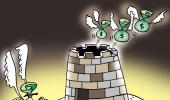All raters need to go for Sadhguru’s internal cleansing process through a forensic review to purge the system if they want to address the huge trust deficit between the CRAs and the investor community.
The onus is on the CRAs to come out clean or face the wrath of the markets and live in shame, says Tamal Bandyopadhyay.
Illustration: Dominic Xavier/Rediff.com

The findings of the interim report of a forensic audit by Grant Thornton, an audit, tax and advisory firm, engaged by the board of the disgraced Infrastructure Leasing and Financial Services Ltd (IL&FS) - detailing the gifts and favours that the senior professionals of credit rating agencies (CRAs) have allegedly enjoyed to keep a rotting company on a high pedestal - exposed the soft underbelly of India’s rating industry.
Till the findings of the report trickled down in the media, the CRAs were criticised for basking in the cool comfort of their offices, oblivious of the ground realities; they miserably failed in their due diligence and acted only when the writing on the wall was visible to the entire world.
The alleged corrupt practices indulged in by the rating officials add a dirty dimension to this.
Both Icra Ltd and Care Ltd have asked their chiefs to go on leave till the investigations are complete.
India Ratings and Research Pvt Ltd has said the senior director in its parent firm, Fitch Singapore, is no longer an employee even as Crisil Ltd has distanced itself from the IL&FS saga, saying it has nothing to do with it.
Let’s take a look at the cultural roots of the CRAs.
The big three - Crisil (1987), Icra (1991) and Care (1993) - have all been promoted by now-defunct development financial institutions - ICICI Ltd, IFCI Ltd and IDBI, respectively.
The secretariat of then ICICI chairman H T Parekh followed an informal process of accepting gifts.
Every Diwali and New Year gift was numbered and kept in the conference room of the office till they were distributed through a draw among peons, gardeners, canteen boys and sweepers.
The gifts were also sent to an orphanage at Girgaum, southern Mumbai.
And, of course, the chairman’s secretariat would send a “thank you” note to all senders, requesting them not to continue with the ritual in future.
I am not aware of the processes followed by IFCI and IDBI.
In the beginning, the bosses of all the rating agencies represented the sponsors and eminent professionals were on their boards.
The rating committees were constituted with members of the boards and care for ethics was an obsession.
The late R Ravimohan, former MD and CEO of Crisil, once remarked: “Credibility is the most valuable asset on our balance sheet; unfortunately accounting standards do not permit recording and valuing the same.”
Other rating agencies such as Acuité Ratings & Research Limited (formerly SME Rating Agency of India Ltd, promoted by Small Industries Development Bank of India and Dun & Bradstreet in 2005), Brickwork Rating India Pvt Ltd (2008), and India Ratings and Research (in early 2000 Fitch bought stake from Dun & Bradstreet Corporation and raised it gradually) by and large adopted the culture of the big three.
International tie-ups and technical assistance - Standard & Poor’s for Crisil, Moody’s Investor Service for Icra, Department for International Development, UK, for Acuite Ratings and Fitch group for India Ratings - have given further impetus to governance and transparency.
The boards of agencies have adopted governance policies defining conflict of interest, disclosure norms and rules for accepting gifts, favours and gratifications with predetermined monetary value.
All these are documented and a part of the employee engagement rules and ethics policy; the compliance officers (usually the company secretaries) are tasked with their implementation.
Apart from chocolates and dry fruits, office utility articles such as calendars, pens and pen stands, pots and plants, coffee table books feature in the permissible list but the employees are expected to return the gold-plated miniature Ganesha and Lakshmi idols, Montblanc pens, smart phones and iPads.
Incidentally, the salary and emoluments (including stock options) of rating agency employees are on a par, if not better, than what the banking and finance industry offers.
Although the Grant Thornton report deals with only the IL&FS case, people familiar with the industry say at least for a few CRAs, the internal norms are relaxed and it is not difficult to find people from the rating fraternity enjoying cruise trips in Greece, Spain and Alaska.
The not-so-senior managers enjoy free stays at cottages in beach resorts (Goa), tea plantations (Coorg), wildlife sanctuaries (Jim Corbett National Park) and hill stations (Shimla), courtesy the rated entities.
Rating is a process-driven exercise; direct interactions with the entities being rated are restricted.
As the rating symbol captures “timely payment of interest and principal”, the emphasis is on free cash flows and the rated entity’s ability to service debt obligations (both interest and principal).
Typically, the CRAs follow an unwritten rule that a minimum of two people meet their clients (to weed out any subjectivity in their analysis) and the focus is on business model, competition and professional competence apart from parentage and succession planning among other things, while evaluating companies raising debt.
For all rating exercises (new as well as surveillance), apart from a primary analyst, there is a principal analyst and a relationship head as well as a sector specialist involved.
All issues are discussed before a presentation is made to the rating committee of directors for considering a fresh rating and continuation/revision (upward or downward).
Now, it seems such a process could be sham and ratings can be influenced.
At the beginning of the century, for expanding their market share, a few CRAs had introduced an unsolicited exercise in the garb of visibility ratings or shadow ratings.
They rated companies based on information available in the public domain.
Such ratings were first informally shared with the companies and only after they were accepted, the rating exercise would start with an official mandate.
The products fizzled out after the market regulator came down heavily on them even though it has been a global practice.
That may be a not-so-proper business practice but the current problem is much deeper.
What needs to be done to cure the maladies?
Should the salary and stock options of CEOs be ploughed back if they are found guilty?
All raters need to go for Sadhguru’s inner engineering (internal cleansing process) through a forensic review to purge the system if they want to address the huge trust deficit between the CRAs and the investor community.
Indeed, banks, NBFCs and other lenders have their own internal rating systems but they also need the certificates of the raters.
Even the Insolvency and Bankruptcy Code stipulates investment grade rating from two agencies to move ahead with a resolution plan for bad debt of at least Rs 500 crore and more.
The onus is on the CRAs to come out clean or face the wrath of the markets and live in shame.
Tamal Bandyopadhyay, a consulting editor of Business Standard, is an author and senior adviser to Jana Small Finance Bank Ltd. Twitter: @TamalBandyo












 © 2025
© 2025